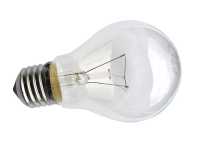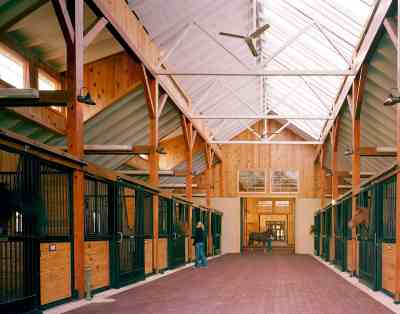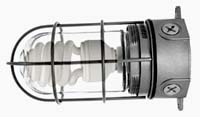|
By Jerry Tardif
Editor's note: This article was published in the February 2009 issue of "Practical Horseman" magazine.
"Practical Horseman" also has articles about many aspects of training and riding horses — check them out!
Though the days are slowly starting to stay lighter longer, you're still probably doing plenty of barn chores with the lights on.
With today's rising electricity rates, now is the perfect time to examine your barn lighting to see if it's meeting your needs and your budget.
Lighting is especially important in smaller, older barns because many are still lit with that staple of electric lighting: the incandescent bulb.
While it's served barn owners well for over a century, there is a better alternative: compact fluorescent lights (CFL).
While you've probably heard why this type of bulb can save you money in your home, in this article, I'll explain the nuts and bolts of how incandescent and fluorescent lighting work and how much money fluorescent lighting can save you in your barn, too.
An incandescent bulb converts most of the electricity to heat rather than light and puts out only about 17 lumens per watt — it's one of the most inefficient users of electricity.
It lasts an average of only 1,000 hours.
Besides having tradition on their side, incandescents are also cheap at $1.20 per four-pack, or 30 cents per bulb.

|

|
|
Fluorescent Bulb
|
Incandescent Bulb
|
Fluorescent lighting is more efficient because less energy is converted to heat.
You get about four times the light-60 to 80 lumens per watt on average — for the same amount of electricity used when compared to incandescent lighting.
In addition, fluorescents generally have a lifespan of 10,000 hours.
The new compact fluorescent bulbs screw directly into incandescent bulb sockets and are generally rated for temperatures down to minus 20 degrees Fahrenheit.
A 14-watt fluorescent bulb provides the same amount of light as a 60-watt incandescent bulb.
These fluorescent bulbs are available at almost all hardware stores and home centers as well as large department stores and list for about $8 for a four-pack, or $2 per bulb.
One drawback to fluorescent lighting is that it is less bright when initially turned on, especially in cold weather.
But the bulbs reach full brightness within two or three minutes.
To understand the cost savings involved in replacing incandescent with fluorescent bulbs, take a small four-stall barn that has three 60-watt incandescent bulbs in the aisle and one bulb per stall, as well as one in the tack room and wash stall each, for a total of nine.
If those lights are on for an average of eight hours each day and you're paying about 16 cents per kilowatt-hour, your annual electricity costs are $28.03 per 60-watt incandescent bulb or $252.27 per year for nine bulbs.
In addition, this represents 26,280 bulb hours each year, meaning you'll replace bulbs about 27 times.
Twenty seven bulbs at 30 cents each is $8.10, plus $252.27 for electricity, totals $260.37 for your annual lighting cost.
If you replace those nine bulbs with compact 14-watt fluorescents at a total cost of $18 ($2 each), your electricity usage costs will drop to $6.54 per bulb or $58.86 for the nine bulbs for the year.
Adding the purchase cost of the fluorescent bulbs, your total barn lighting costs for the first year will be $76.86 — you save $183.51 the first year you convert.
Because the fluorescents last 10 times longer, your savings rise as you replace only three bulbs per year for the following years, and your total lighting costs will be only $64.86 for a year of bulbs and electricity.
Your savings will be even greater if any one or more of the following is true at your barn:
- You use larger bulbs (e.g., 75-watt or 100-watt).
- You pay more than 16 cents per kWh.
- You leave your lights on for more than eight hours each day.
- You have more stalls or use more bulbs in your barn.
See the table below for a more detailed comparison:
Here is the annual electric cost comparison of a incandescent bulb versus a fluorescent bulb left on for eight hours a day.
The cost is the kilowatt-hours times the electric rate you pay.
|
| Bulb Type |
Lumens |
Annual kWh Used |
Cost @ 16¢/kWh |
Cost @ 20¢/kWh |
Cost @ 24¢/kWh |
| 60W Incandescent |
900 |
175.2 |
$28.03 |
$35.04 |
$42.05 |
| 14W Fluorescent |
900 |
40.88 |
$6.54 |
$8.18 |
$9.81 |
| Annual Savings w/Fluorescent |
$21.49 |
$26.86 |
$32.24 |
|
| 100W Incandescent |
1,750 |
292 |
$46.72 |
$58.40 |
$70.08 |
| 27W Fluorescent |
1,750 |
78.84 |
$12.61 |
$15.77 |
$18.92 |
| Annual Savings w/Fluorescent |
$34.11 |
$42.63 |
$51.16 |
There are other lighting technologies, but they have limitations or are not currently appropriate for small barns.
For example, metal halide fixtures are even more efficient, but only work well for larger barns and arenas where ceilings are at least 12 to 15 feet or higher.
Similarly, the new LED (light emitting diode) fixtures are currently expensive and too small to throw enough light for barn use in their current sizes.
But watch for them in the news — they're the "wave of the future" and will be even more efficient and cost-effective than fluorescents within the next five to 10 years.
|
Overall, when evaluating how to best light your barn, first consider bringing in as much natural light as possible. It's not only brighter and more appealing, it's also FREE.
In homes, skylights can be a mixed blessing because they can contribute to unwanted heat gain in the summer and heat loss in the winter.
But barns should be well ventilated to minimize the buildup of ammonia from horse waste products.
Therefore, heat loss and gain are not problems when sky-lighting barns.

Photo Courtesy of Blackburn Associates
|
|
Skylights will initially cost you more, but the savings in electricity can be significant because you don't use as many lights, not as often.
|
If building a new barn, consider having your architect include skylighting.
The savings in electricity can be significant even though these panels will initially cost you more.
And you'll never regret the bright, open feeling they provide, even on overcast days.
John Blackburn, of Blackburn Architects, P.C. suggests purchasing translucent skylight panels because they will distribute the light better and make it a more even, softer light.
Transparent panels don't diffuse the light, often rendering it too harsh with too much contrast.
What does paint have to do with barn lighting?
Plenty!
The color of the ceiling and surrounding walls has a major impact on the effectiveness of your lighting.
Many dark barns usually have dark timbers and sometimes are covered with dark paint.
A light-colored paint can vastly improve your ability to see in your barn even with its less-effective, existing lighting.
Don't get white, which better shows dirt.
Use a slightly darker color, such as a cream or ivory semi-gloss.
If you're a barn owner who annually or biannually water-sprays barn ceilings and walls to clean them, dirt is more easily released from glossier surfaces — it has less to "grab on" to.
Conversely, there are "textured" paints in most colors that better hide nail heads and wood imperfections, though they're harder to clean.
Paint the overhead beams and at least the upper walls.
As a side benefit, Blackburn says that even bird droppings will be far less noticeable, and often invisible, on a lighter-colored surface.
If you paint your ceiling, he advises using slightly higher wattage, reflector-type aisle lights and turning them upward to get a more uniform lighting throughout your barn.
With this approach, you may not even need individual stall lights or will find that you use them far less frequently.
Everything you can do to make the most of natural light and any electric light will save you money every month and make your barn a more appealing and easier place in which to see and work.
|
Regardless of type, each light should have dust- and moisture-resistant covers and be surrounded by a globe cage, vapor-proof, or safety-glass fixture.
They should also be placed 10 feet or more high, if possible, to prevent accidental breakage (a dust cover also will help prevent fires).
This is especially important in your wash stall if you have one.
While fluorescents run much cooler than incandescent bulbs, cold water splashed or accidentally sprayed on any very warm bulb can cause it to break.

|
Regardless of the type of bulbs you use, it's a good idea to enclose bulbs in a vapor proof fixture if they are close to a spray source (wash stall) or are low enough to be reached by a horse (e.g. rearing).
|
Barns don't need to be dark, dingy enclosures for our favorite four-legged friends.
With modern bulbs, use of free, natural light, and smart use of light paint colors, they can be bright, welcoming spaces that make horse care easier and more fun.
Besides being an avid trail rider, Jerry Tardif is a technology consultant and a horse and nature photographer in SE Connecticut — see his work at: www.jerrytardif.com.
He is also co-founder and President of QueryHorse.
Back to Article Index
|